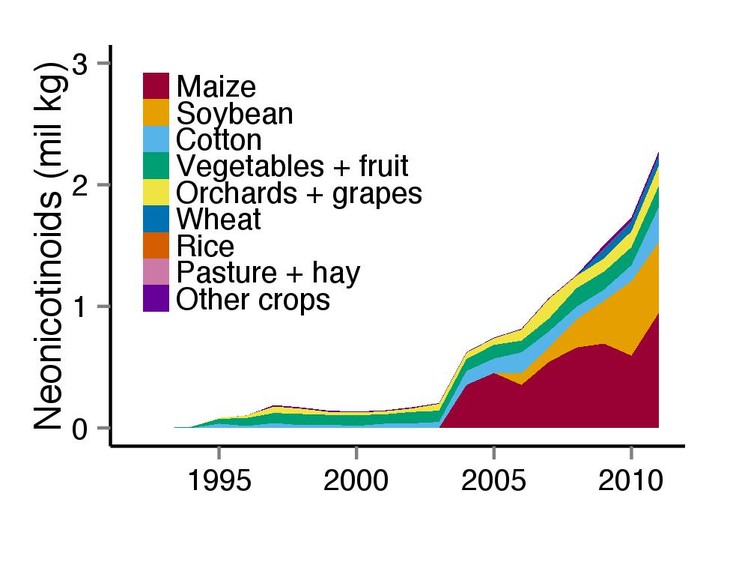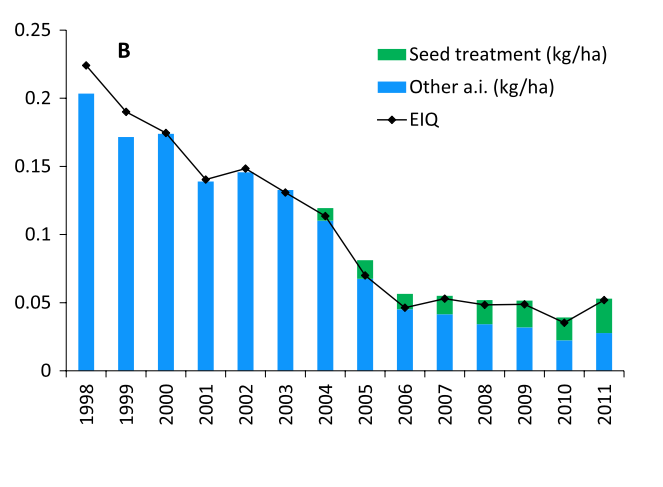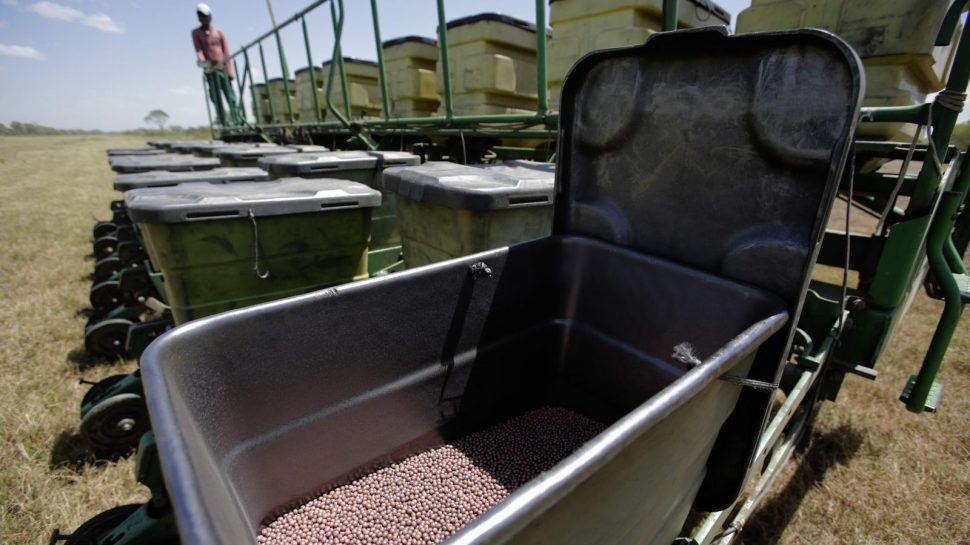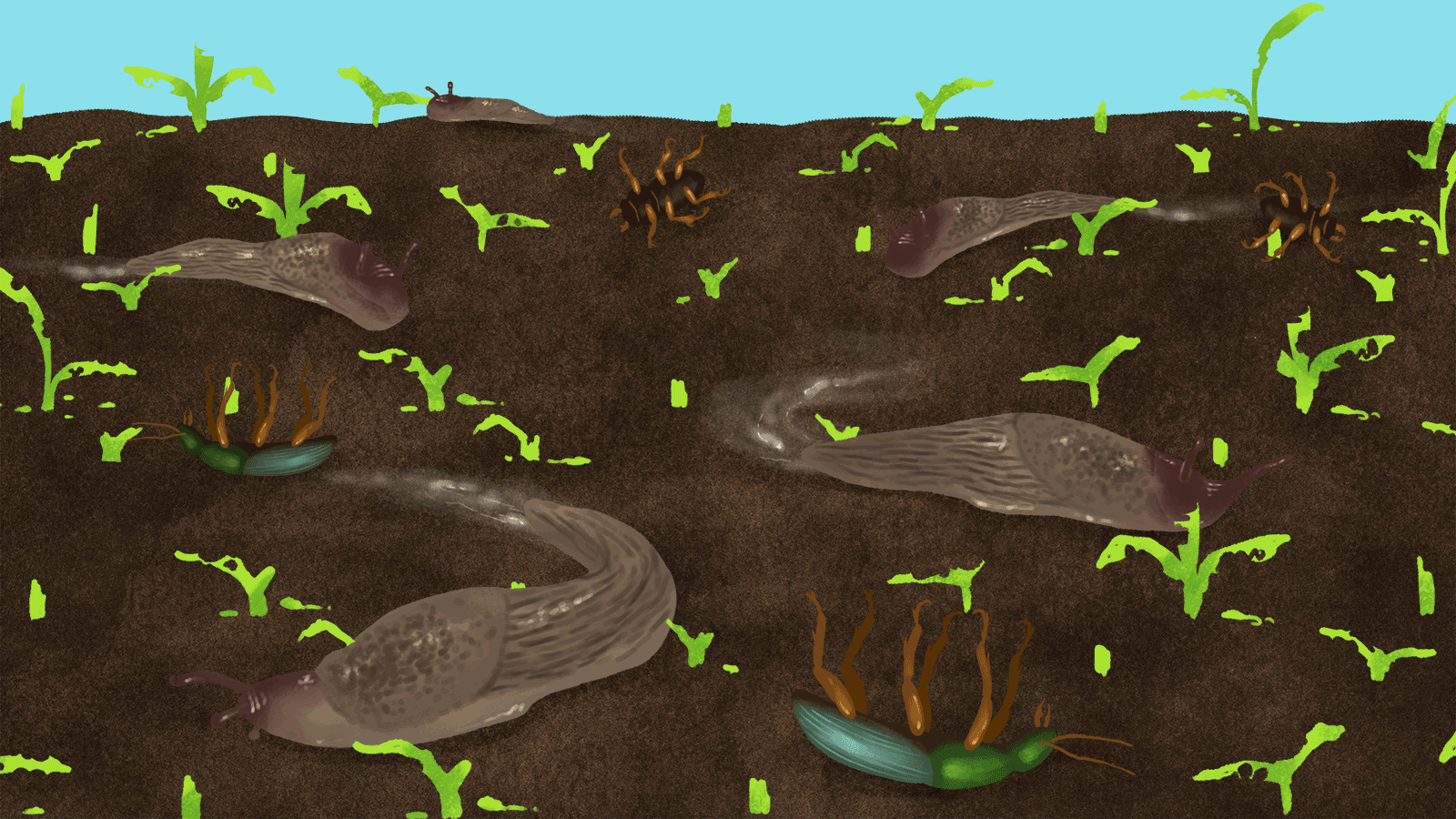It was the closest thing you get to a blind date between a scientist and a journalist.
I had never met the entomologist John Tooker before he opened his door at Penn State, where I was giving a lecture this April, and invited me into his office. Tooker is tall, lean, and balding, with expressive black eyebrows and ears that stick out from his skull. He leaned back in his chair and linked his hands behind his head.
“I thought it might be worth meeting,” he said, “because I read the piece where you said GMOs had decreased the amount of insecticide used.” This is an important data point in the ongoing debate over the environmental effects of GMO crops. As long-time Grist readers know, I’ve explored this topic in depth.
“Well,” Tooker continued, “in 2015, we published a paper showing that they’ve actually driven insecticide use up.”
I gaped. Even anti-GMO partisans generally accept the premise that genetically modified crops have reduced insecticide use. For a moment I worried Tooker might be crazy, determined to hold me captive while he ranted. But as an entomologist and agricultural extension specialist, he was sure to be familiar with the evidence. What the heck was going on?
The question of whether GMOs are harmful or beneficial to humanity doesn’t always have an easy answer, and lots of contradictory claims can be made in the debate. Sometimes, it turns out, each claim can be right in its own fashion. Every scientist and activist sees the overall picture from a slightly different angle.
For that reason, I’m always open to a new perspective that challenges what I’ve come to learn over the years of investigating GMOs. (For the record, my personal conclusion is that despite all the dire predictions and heated rhetoric on both sides, GMOs don’t actually matter that much.) So I was more than open to hearing Tooker’s new evidence and exploring where it might lead — once I determined he wasn’t nuts.
The result was a fresh argument for a form of pest control — a golden mean of organic and industrial. Here’s a roadmap of the journey I followed to get there.

Seeds coated with chemicals Shutterstock
First, we’ll need some background. Over the last few decades, farmers have been using more of a type of insecticide called neonicotinoids, or neonics for short. These relatives of nicotine deliver insects a lethal high. (Maybe not such a bad way to go?)
Neonics are mostly used as seed coatings. They’re one part in a cocktail of fungicides, insecticides, and beneficial microbes swaddling nearly every seed that modern farmers stick in the ground — GMO seeds and non-GMO alike. But, Tooker argues that the increase in genetically modified crops is what’s really causing the use of neonics to skyrocket, to the point that just about every kernel of field corn planted in the United States is coated with this class of insecticides.
The reaction to the widespread use of neonics, like so much in agriculture today, has been polarized and divisive.
Farmers love them. “We’ve gone from using pesticides with a skull and crossbones on the label,” Iowa farmer Mark Jackson told me. “I used to lay down a seven-inch band of granular insecticide on the ground over my seeds.”
Those ground treatments and sprays kill beneficial insects along with the pests. But a tiny drop of neonics applied right to the seed casing gets sucked into the plant as it grows. Bugs that chomp down on the neonic-infused leaves get a killer dose of the chemical. What’s not to love?
Environmentalists, by contrast, see neonics as a catastrophe that is wiping out valuable pollinators and other beneficial insects along with their target pets. Greens point to studies that suggest farmers gain little to no economic benefit from seed treatments. There’s some evidence — in Europe, at least — of a marked decline in many insect populations, although data on what’s causing this remains scant. (I go deeper here, if you want more background on the bee crisis and its possible causes.)
Farmers can’t see any downside to neonic seed treatments. Environmentalists can’t see any upside. When people can’t see the other side of any debate, they become vulnerable to a form of blindness. Which is what made me wonder: Has everyone become so blinkered that we’re unable to see what Tooker sees, and there really is a massive, under-the-radar increase in insecticide use?
The fascination with GMOs and neonics got its claws into Tooker at a breakfast meeting with farmers. As part of his job at the ag extension service, he visits with farmers across Pennsylvania to provide advice and learn what about their challenges.
When he walked through the doors of Ard’s Farm Restaurant in Lewisburg, a small town on the Susquehanna river, eight years ago, he was expecting maybe five people to show up. Instead, some 30 farmers looked up from their coffees. Tooker ordered fried eggs and scrapple and asked what had brought everyone out.
The answer: slugs. Thousands of eraser-sized grey slugs were appearing in fields at dusk and gnawing through the stems of the sprouting crop, killing plants en masse.
This was weird. Slugs are usually controlled by insects — including a couple species of ground beetles common to Pennsylvania. To figure out what was going on, Tooker and Margaret Douglas, then a grad student, began setting up little terrariums — clear plastic half-pint cartons (like for your potato salad) with a little dirt in the bottom.
These were tiny coliseums for a clash of mortal foes — slugs versus beetles. Douglas called the containers “arenas.”
“It’s like something you’d see on YouTube,” Douglas says. “Spider versus wasp!”
Slugs are hard to kill. There are a few molluscicides out there, but they’re expensive. And even their born predators, the ground beetles, have trouble taking them down.
“They produce a protective slime,” Douglas said, “so when they are attacked, that slime gets all up in the predator’s mouthparts, and it’s pretty disgusting, though there are some predators that can deal with that.”
Still, when the beetles got hungry, they chowed down on the slugs — slime be damned. To add a touch of farmland verisimilitude, and to see how well beetles might protect a crop from ravenous slugs, Douglas germinated a few seeds that had been sitting in the lab refrigerator and placed a few sprouts in each arena. Then she went home.
The next day, she found the seedlings shredded, and every beetle dead. The slugs were snoozing, their bellies full.
Tooker and Douglas quickly realized that the seeds Douglas had used were coated with a mix of chemicals, including a neonic insecticide. As they sucked up water in the germinating tray, the sprouts had also absorbed the neonics, which bind tightly to water molecules and hitch a ride into plant cells.
The slugs ate the plants, and the insecticide had spread through the molluscs without harming them. When the beetles attacked the slugs, they got a mouthful of poison and keeled over.
Douglas and Tooker confirmed this narrative with further experiments, then published their work and took their findings back to farmers. They suggested that farmers could control the slugs in part by planting seeds without neonics on them.
But farmers told them it was hard to find the seeds they wanted without the insecticides, especially if the seeds were GMOs. Tooker and Douglas started to wonder how widespread neonics were, and realized that nobody knew; the Department of Agriculture hadn’t been tracking seed treatments in its pesticide surveys.
After some sleuthing with government data collected by other agencies, they published a 2015 paper showing that neonic use had ballooned.

Neonics go boom Tooker and Douglas
What wasn’t clear in their paper documenting the increased use of neonics is why Tooker contended that GMO seeds had driven that growth more than non-GMOs. It was only after I spoke with Scott Beck, president of Beck’s Hybrids, an 80-year-old family business in Indiana, that the possible relationship between GMOs and neonics became clear.
Back in the 1980s, when seeds were relatively cheap, farmers often planted extra in their fields, Beck said, expecting to lose some. But then, with the advent of biotechnology in 1996, seed prices rose.
At that point, he said, it no longer made sense for farmers to buy more seeds than they needed. Better to protect their pricier genetically modified seeds with insecticides like neonics.
So is Tooker right that farmers are using more insecticides than they would be without biotechnology? Certainly it might look that way from the perspective of a ground beetle, and talking to Beck had helped me understand Tooker’s argument.
But the numbers don’t add up if you are measuring insecticides by the pound. Take, for instance, this recent study: It counted neonic seed treatments and confirmed the conventional wisdom that GMOs were responsible for a big drop in insecticide use.

This shows kilograms per hectare of seed treatments — in green — and other insecticide — blue — on corn in the United States. Perry et al.
After a little follow up, Tooker conceded that he was making a bit of leap from his 2015 paper on the increased use of neonics to placing the blame on GMOs. He suggested I talk to Douglas, his research partner.
“She’s a bit more cautious,” he admitted wryly. “Sometimes I let my mouth get out ahead of me.”
When I got her on the phone, Douglas explained that farmers are using less insecticide, but spreading it over a much larger area. Whether that’s good or bad depends on what you care about.
If you are worried about toxicity to humans, things are improving. But if you care about insects, the ubiquity of neonics may very well mean we’re looking at an increasing threat. Measured in acres treated, it looks like we’ve reached an all-time high in the use of neonic seed treatments. Now they’re spread over 90 percent of corn fields and a little under half of soy fields, Tooker said.
That’s when it finally clicked for me: Tooker studies insects that live on farmland. The bugs he cares about are experiencing a massive increase in poisoned habitat.
For people who care about bugs, neonics have a trio of troubling attributes: They can persist in soil for years; they bind to water molecules, so they’re liable to wash into creeks; and they are lethal to insects at microscopic doses.
Scott Black is one of those people who cares. He is the executive director of the Xerces Society, a conservation nonprofit for bugs. Black isn’t an anti-neonic crusader. He knows that if neonics were banned, farmers could replace them with other insecticides. He understands that habitat loss, climate change, and many types of pesticides are ganging up on bugs.
Nonetheless, he thinks neonics deserve special attention. At this point, he said, they are the most widely used insecticides in the world.

Soybean seeds in the bins of a planter REUTERS/David Mercado
GMOs certainly aren’t the only force driving the spread of neonics. Farmers told me seed treatments became more important as they embraced cover crops and no-till practices. Because they had stopped plowing, there was more insect life in their fields. Naturally, some of those insects liked to eat sprouting grain.
The seed treatments seemed like the perfect solution: Instead of spreading chemicals on their fields and killing good and bad species of insect alike, farmers could use a fraction of a gram with pinpoint accuracy, applied to their seeds.
Tooker says seed treatments can be great if used strategically. When he and Douglas started sharing their findings about beetles and slugs, they hoped their research might turn farmers away from the preemptive use of insecticides and toward integrated pest management.
That’s a practice that takes the best from both organic and conventional farming. You encourage natural predators and let low-level pests go untreated. But when an infestation threatens, you make a surgical strike with the best available chemical.
This practice would take more work for farmers — and create more worry — but it would save them money, keep pesticides working longer (the more you apply, the more their targets breed resistance), and might just bring back a host of beneficial insects, like slug-eating beetles.
Interestingly, the ag giant Monsanto’s chief technology officer, Robert Fraley, says that technical advancements — like down-to-the-meter mapping of fields — are making it easier for farmers to adopt this method of dealing with pests. Savvy farmers will soon be tricking out their seed planters to place insecticide-treated seeds in one spot, anti-nematode seeds in another, and a high-yielding hybrid in another, Fraley told me.
“Planters used to be like inkjet printers,” he said. “Today’s planter, you have to think of as being a 3D printer.”
To reduce the use of neonic-coated seeds, though, first you’ll have to convince farmers that there’s a problem with them. Even the enlightened ones I talked to who already use integrated pest management don’t see any harm.
But Tooker’s findings (along with those of many other scientists) suggest that there’s an underappreciated danger in routinely applying tiny amounts of insecticide over huge areas. If farmers could see things from the perspective of their allies, the slug-chomping beetles, it might plant an important seed of understanding.
We could stand to cultivate a lot more of that in the GMO wars.




